Managing soil means managing water, say farmers who have worked hard to maintain their soil while growing high yielding crops.
Why it matters: Soil organic matter levels continue to decline across major agriculture areas. The solutions are complex and sometimes contradictory, and often depend on local soil quality.
“Healthy soil means faster water infiltration,” said Ken Nixon, a farmer from the Ilderton area. When the soil supports the infiltration of water, it means greater carrying capacity for equipment and quicker residue decomposition, he said.

Nixon told farmers attending a soil health panel at the recent Farm Smart Conference in Guelph he had a moment of revelation when researching yield monitors in the early 1990s and talked to an early adopter who told him that what he had learned from monitoring yield was that it wasn’t fertility that held it back, but water availability.
Water helps create healthy crops by, among other things helping root development, which also reduces compaction.
Nixon farms with his father George and brother Ken within 15 miles of their home farm just north of London, where they use no-till, strip tillage and low-compaction equipment to manage soil health.
Managing water flow
Kate Procter told participants that she also found that managing water flow on her farm is important to maintaining fertility and profitability.
Read Also

Scientists discover a gene that could triple wheat production
This discovery could give breeders a powerful new tool to boost yields without needing more land, water, or fertilizer.
“We do lots of thinking about water,” she said.
They have been gradually fixing problem water areas on the 1,200 acres she runs with her father and a cousin in Morris-Turnberry in Huron County.
The farm got rid of its plow in 1992, so Procter has never plowed, although they had to have someone plow a piece of land they tiled last year that turned out to be a rough ride for Procter in the combine this fall.
Most of the fields they run have been systematically tiled, but there are still issues in some areas and they have installed grassed waterways and berms where needed.
Procter outlined a project they recently completed to deal with a chronically eroded area.
A 2015 yield map showed an area of very little yield in a part of a field on the farm where Proctor lives.
“There was nothing but stones,” she said, noting it wasn’t much more than a bad weed nursery.
They brought in a bulldozer to clean up the stones, put in a 15-inch tile, added new topsoil and seeded the area down in grass.
“It wasn’t profitable anyway,” she said.
Clearer water after large rainfall events from their tiles that run into the nearby Maitland River tell them that they are making progress.
Most of the Procters’ acres are no-tilled using a 1790 JD planter, but they also take the manure from a 900-head sow barn, some of which they incorporate.
“Manure is a challenge for us.”
They don’t use a lot of cover crops yet, as they do some no-till, but Procter said it is an area they are examining.
Organic challenge
Brett Israel has an even more complex system to manage where he farms with grandfather Carl and father Jamie near Drayton, as they are organic.
“We know reducing tillage is important, but in the organic system we have to be profitable, and keep weeds under control as well,” he said.

He said they are constantly looking for ways to reduce tillage without compromising grain yield.
The Israels have to find non-chemical sources of fertility, so manure from their hog operation is critical. Cover crops are also important, planted after wheat, or other spring grains. They broadcast the cover crop seed, which can range from a three-way to a 14-way mix, using a Gator. Then manure is applied and tilled in, which helps the cover crop to catch.
They will often disc in a cover crop in the fall to terminate it, but they have to watch how much biomass there is. Too much and it can look great, but also can suppress the next year’s crop.
Have a look at what problems you are trying to solve before deciding a cover crop mix.
“Don’t just choose something because it looks fancy.”
They interseed cover crops in corn with a seed box put onto their Kongskilde Intellivibro cultivator. He doesn’t find that the cover crop interseeded in corn creates a yield drag in the corn. They apply it during their last scuffling pass through the corn crop. They plan to try interseeding in soybeans.
“One day if we can reduce or eliminate tillage in organic system, it will be because of cover crops. We are working towards that goal.”















